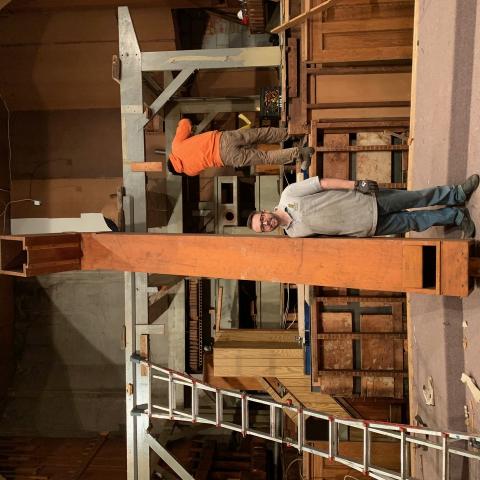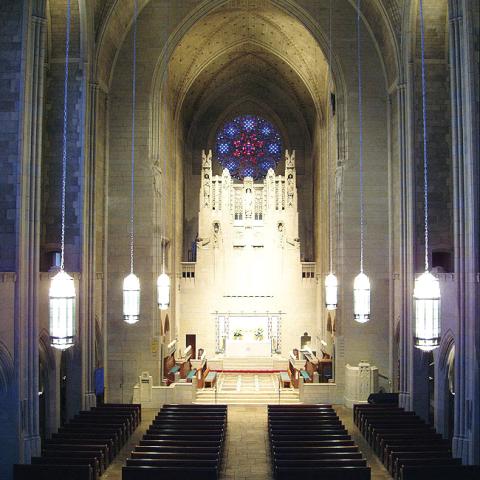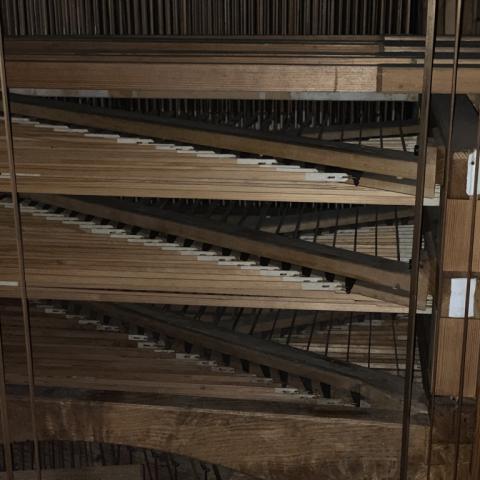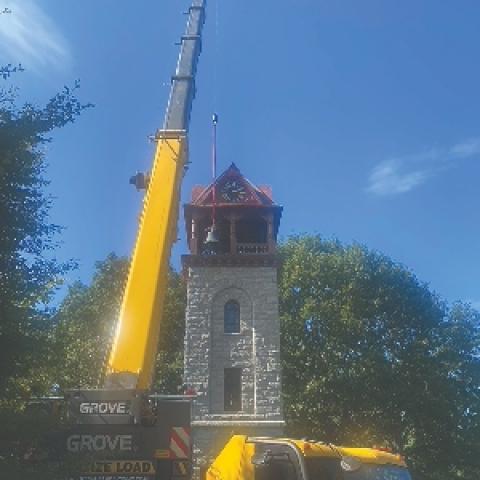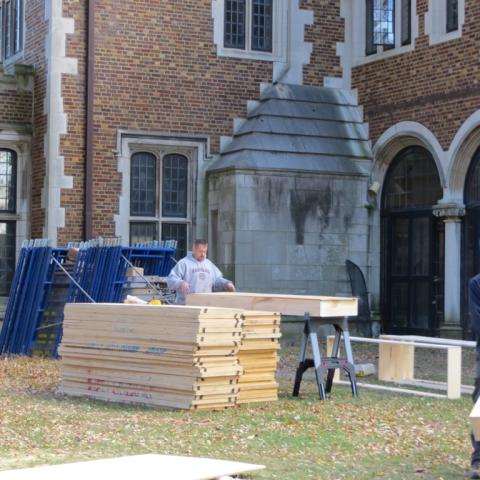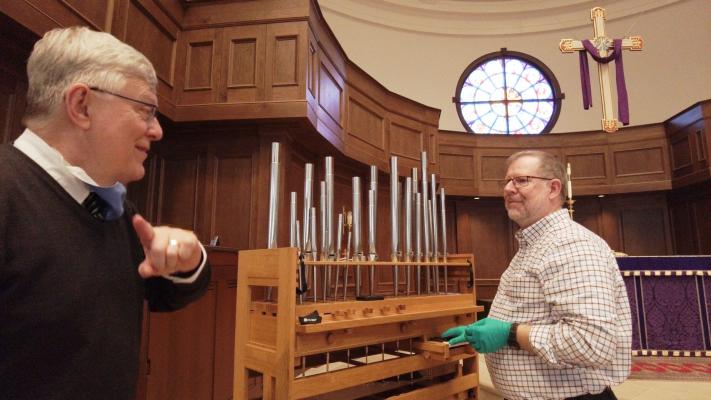
Make me an instrument.
I have been involved in the world of building musical instruments since I was about twelve years old as the organist of my home church, where my father was rector, was the harpsichord and clavichord builder Carl Fudge. On occasion, he brought one of his instruments to the church for a special performance, and at that tender age I was fascinated by the concept of playing an instrument you had built yourself. I have thought about that continually in the past fifty-plus years, so my feelings and perceptions have become more sophisticated, but I know I was in awe of Carl’s skill as both instrument maker and musician. Visiting his workshop, I was further enthralled, I started taking organ lessons, and my life’s path was set.
Longtime readers of this column will recognize that one of my favorite subjects is writing about one’s relationship with one’s instrument. In his book Violin Dreams (Houghton Mifflin, 2006), Arnold Steinhardt, first violinist of the Guarneri Quartet wrote:
When I hold the violin, my left arm stretches lovingly around its neck, my right hand draws the bow across the strings like a caress, and the violin itself is tucked under my chin, a place halfway between my brain and my beating heart.
Lovely, isn’t it? What a poetic description of a musical relationship. But his next sentence throws most of the rest of us under the bus.
Instruments that are played at arm’s length—the piano, the bassoon, the tympani—have a certain reserve built into the relationship. Touch me, hold me if you must, but don’t get too close, they seem to say. . . . To play the violin, however, I must stroke its strings and embrace a delicate body with ample curves and a scroll like a perfect hairdo fresh from the beauty salon. This creature sings ardently to me day after day, year after year, as I embrace it.1
In that light, I imagine Steinhardt would equate organists with truck drivers, sliding onto the bench, flipping a switch to turn on a ten-horsepower motor, and playing the instrument by remote control, twenty, fifty, or a hundred feet away.
I hope he likes it.
Nearly thirty-five years ago, my siblings, mother, and I commissioned a local artist to paint a picture of the red barn behind our parents’ house on Cape Cod in honor of dad’s retirement. We sent her photos of the barn, and she visited there several times in secret. The painting was to be unveiled at “the party” in front of family and friends, and there was an air of excitement, but when the cloth was removed there was silence. It did not look like our barn. The proportions were akilter, and the shadow of a nearby tree fell across the grass and the barn’s wall in a way no shadow could exist under the sun. It was a stunning moment, a much better story now than an experience then.
§
I have just reread John Marchese’s book The Violin Maker (Harper Collins, 2007), which follows the commissioning and construction of a new violin for Eugene Drucker, violinist of the Emerson String Quartet. (Drucker and Philip Setzer have equal billing, swapping “first chair” duties back and forth.) Drucker had commissioned the legendary luthier Sam Zygmuntowicz of Brooklyn, New York, to build an instrument to complement the Stradivari instrument that he uses in most performances, but which has a temperamental “personality,” especially when the quartet’s travels take them from one climate extreme to another in a short period. The Strad is slow to recover.
Marchese provides plenty of background information including biographical data about Guarneri, Stradivari, and the other Cremonese luthiers. He spent countless hours with both Drucker and Zygmuntowicz, interviewing them and observing them in the workshop, teaching studio, and concert stage. As Sam chose the wood for Gene’s violin, Marchese related stories about the harvesting and aging of wood; luthiers have collections of pieces of maple and spruce that have aged fifty years since they were harvested and milled. The stability of such aged wood is essential to the luthier. We learn of Sam’s apprenticeship and education as a luthier, how he was privileged to take detailed measurements of a dismantled Strad, and how he created a detailed map of the various pieces of the fiddle, measured to the thousandth of an inch. We hear him speaking with and addressing his colleague luthiers at conferences and restaurant tables. Throughout the book, I could hear the undercurrent: “I hope he likes it, I hope he likes it, I hope he likes it.”
Spoiler alert: Sam finished the violin in time to present it at Gene’s fiftieth birthday party amid excitement and congratulations. Gene plays the instrument for his friends, uses it in concert, and practices on it. He swaps back and forth between the new instrument and his trusty Strad. He wants to love it, but just cannot get there. Ultimately Sam acknowledges that he failed to captivate Gene with the new instrument. I recommend this book to anyone who owns and cares for a musical instrument, and to anyone who builds those instruments.
A bargain at twice the price
Nowhere in Marchese’s book is the actual price of a Zygmuntowicz violin stated, but a quick internet search at least implied to me that it is around $100,000. That is about the price of a new Steinway “B,” the seven-foot piano so prevalent in teaching studios and smaller recital halls. A Steinway “B” weighs nearly 800 pounds—the instrument costs $125 per pound or about $9 an ounce. A Zygmuntowicz violin weighs about fourteen ounces, about $7,143 per ounce. By comparison, think of the $15,000,000 Strad at $1,071,429 per ounce.
As a pipe organ builder, I marvel at the idea that a fourteen-ounce violin might be worth $15,000,000. You can build a mighty pipe organ for that amount; in fact few organs have ever cost that much. And does that mighty organ weigh 100,000 pounds? It is a bargain at $150 a pound or $9.38 an ounce. Why would anyone want to buy a violin when they could have a pipe organ?
Let’s buy a pipe organ.
When an orchestral musician purchases an instrument, whether new or “experienced,” it is a personal transaction. The musician is choosing and paying privately. At Eugene Drucker’s level, the price can be a family sacrifice. That money might have gone toward a vacation home or a boat, but the serious musician cannot function without an instrument of high enough quality to inspire his creativity.
The purchase of a pipe organ is typically a community event. When an organ shows signs of failing or when people within an institution advocate for a new instrument, a committee is usually formed to study the situation. Many of these committees engage consultants to inform and advise their work. Organ companies are solicited for proposals, a budget is established, a decision is made, and the hard work begins: raising the money.
The iconic four-manual, seventy-five-rank Flentrop organ in Saint Mark’s Cathedral in Seattle, Washington, was purchased for $165,000 in 1965. In today’s economy, that is about enough money for the copper 32′ Prestant that dominates the façade. The same organ today would cost something like $2,000,000. A three-manual organ with forty stops is likely to cost $1,000,000. That is a lot of money for a congregation to raise, and regardless of the price per pound, it is a lot of money for a small community of people to pay for a musical instrument.
I like to compare that process with a tennis club deciding to build a swimming pool. A few members come up with the idea on a hot afternoon, the elected leadership gets involved, and contractors offer estimates. Perhaps the membership would be assessed to raise some of the money; perhaps members would be solicited to make donations; perhaps there would be a mortgage to be offset by increased membership dues. Whether it is a tennis club building a swimming pool or a church commissioning a pipe organ, there would likely be a parliamentary process of proposing, discussing, and voting, except in those institutions with authoritarian leadership.
I have long believed that the easy part of the process is building the organ. With decisions made and money raised, an organ builder receives some of that money and gets to work doing what he knows how to do.
I hope they like it.
My comment about building an organ being the easy part notwithstanding, it is a complex task. Where do you start? What is it going to sound like? A point of departure is the determination of scaling of the organ pipes and the wind pressure. The length of organ pipes is pretty much given by the physics of musical tone. To produce low CC, the lowest note of the keyboard, on a unison stop, the speaking length of the pipe from mouth to tuning point is eight feet. The question is, what should the diameter of the pipe be? Are you hoping to achieve a brilliant “baroquey” sound with narrow scales, a lush romantic sound with wide scales, or something in between? Higher wind pressure translates easily into more powerful tone, though there are plenty of examples of low-pressure organs with bold voices.
You can study examples of organs in comparable buildings, measuring the scales and other dimensions of the pipes, and maybe altering the numbers for slightly smaller or broader scales. Some organ builders are brilliant at imagining the tone of a particular scale within a building and designing the rest of the voices to be compatible with the first. For a more certain study, it is increasingly common for an organ builder to bring a portable organ with wind supply and a collection of sample pipes of different dimensions allowing him to compare different scales and wind pressures. It is an expensive process involving travel, lodging, and shipping the equipment and supplies, but if the organ has a million-dollar price tag, it is a modest investment. There is no substitute for producing actual tones in the actual acoustical environment.
Think of the myriad individual projects that make up a completed organ. Artisans are building windchests, reservoirs, keyboards, consoles, wind conductors, mechanical or electric actions, casework, ladders, walkboards—the list can seem endless. And what about ornate decorations like pinnacles, pipe shades, and putti?
Like Sam Zygmuntowicz choosing the wood for a new violin, the organbuilder is on a constant search for good materials. I remember my mentor John Leek in Oberlin, Ohio, in the 1970s purchasing a rare log of boxwood seven or eight feet long and eight inches in diameter for making the sharp keys of his organs and harpsichords, and gorgeous European beechwood for harpsichord bridges and nuts (the slim rail ahead of the tuning pins that lifts the strings off the pinblock). He ordered them through his friends at Flentrop Orgelbouw in Zaandam, the Netherlands, who shipped them to Cleveland in the sea-going container that delivered the brilliant Flentrop organ for Trinity Episcopal Cathedral in Cleveland. Each time we set out to make a set of keyboards, we lopped a piece off that boxwood and milled it into those familiar tapered shapes.
John Boody of Taylor & Boody organbuilders in Staunton, Virginia, specializes in harvesting trees and sawing lumber for their instruments. His appreciation of the beauty of wood allows the artisans there to choose ideal boards for special places. Gorgeous woodgrain patterns on organ benches, around keytables, and casework is a hallmark of their instruments, and John’s care with quarter-sawing and drying the lumber produces especially stable material. In 2009, Wendy and I visited John and Janet Boody as part of a trip to Washington, DC, and Thomas Jefferson’s Virginia home, Monticello. We stayed in an apartment above John’s sawmill and saw the stacks of dried oak boards that would become the case of the new organ at Grace Episcopal Church in New York City.
George Bozeman, another of my mentors, held the concept that wind is the fuel we burn to make organ tone. Any pipe organ has a complex system to produce wind pressure (the blower), transport it to reservoirs and windchests (wind ducts), and regulate it to an exact and steady pressure (reservoirs, also known as regulators). “Bellows” is a term universally used to describe reservoirs/regulators, but I understand a bellows produces wind pressure, as found in the hand-pumped organs of earlier years, or the bellows next to your fireplace. A reservoir stores pressurized air, and a regulator regulates the pressure with internal valves that allow air to flow to the windchests only when the organ is being played and wind is being consumed. Both reservoir and regulator refer correctly to those components of a modern organ wind system, as the pressure is created by an electric blower. Steady, reliable pipe speech relies on steady, reliable wind pressure.
There are two basic types of structure for pipe organs. Some instruments have interior “skeletons” of wood or steel that support windchests, reservoirs, expression boxes, and the ladders and walkboards necessary to reach them all. Others are supported by their free-standing cases. The upright styles of the lower case support the impost, the heavy frame that includes the bases of round or pointed towers. In the case of the Flentrop in Cleveland I mentioned earlier, the impost was by far the heaviest single part of the organ, and the core of its structure. The upper-case panels and styles fit into mortices in the impost and in turn supported the majestic tower crowns. The Pedaal and Hoofdwerk windchests sat on the impost.
In either type of construction, the musical stability of the instrument is a direct factor of its structural stability, especially with mechanical key action, as any motion in the structure affects the adjustment of the action. Organ pipes must be supported to stand perfectly vertically, especially when the pipe metal is soft, as gravity will grab any leaning pipe and try to pull it to the ground. Reed pipes need special support because they are skinniest and weakest at the bottom of the resonator where it intersects with the pipe’s boot. Any organ builder or technician can tell stories about larger reed pipes collapsing on themselves, sometimes breaking free of their supports and crashing down on neighboring pipes.
The proof is in the pudding.
With beautiful wood chosen, accurate actions built and adjusted, wind system regulated and free of leaks, it is time for the pipes. It is a magical moment when an organ produces its first musical tones in its new home. Sometimes we let people in the church know when we expect to sound the first notes. We have already had the excitement of turning on the blower for the first time, experiencing the organ coming to life. People gather, a rank of pipes is placed in their holes, and an out-of-tune hymn is played. After thousands of hours in the workshop, days or weeks of heavy lifting, and precise fitting, the heart of the enterprise comes clear.
What about Eugene Drucker’s reaction to his new instrument? Will the new organ be all everyone hoped for? The local organist will have the strongest reaction, the choir and other musicians who will use the instrument follow suit. The people in the pews will have their opinions. In 1982, John Leek and I installed a new organ we had built at Saint Alban’s Episcopal Church in Annandale, Virginia. The previous organ was a nondescript “asparagus patch” of exposed pipes with little stature; our instrument had a tall case of oak and walnut with classic pointed towers and moldings and shiny façade pipes. We delivered the organ on a Sunday afternoon, and by the following Sunday the case was standing, giving the impression of being complete. John and I sat in the pews as the congregation filed in, found their seats, and craned their necks to see the new organ in the rear balcony. In the quiet of the moment, a young girl cried out, “I liked the old one better.”
Notes
1. Arnold Steinhardt, Violin Dreams (Houghton Mifflin, 2006), 5.

